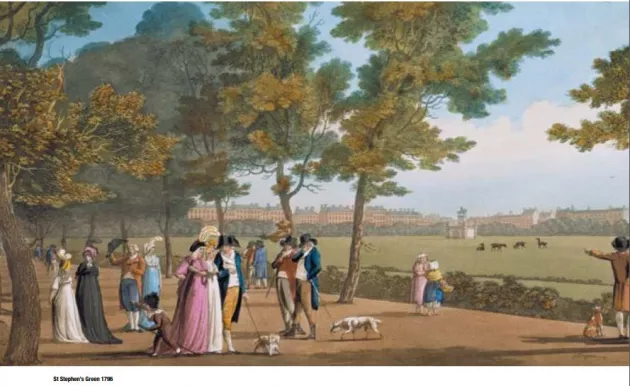2.1.5 Georgian Dublin
2.1.5 Georgian Dublin
Dublin’s population expanded rapidly from 75,000 in 1710 to 150,000 in 1756.
The Georgian era Dublin (1714-1830) saw a more plan-led and controlled form of development. Due to major congestion in the medieval streets, the Wide Streets Commission was established in 1757. The Commission widened medieval streets and constructed bridges, which changed the axis of the city from east-west to northsouth. The Grand Canal and the Royal Canal were also constructed in the 1700s, and had an influence on the development of the city, with the suburbs developing outside these city “rings”. They were the transport corridors of this time but now serve the city as linear recreational and biodiversity resources.
One of the most significant characteristics of this period, and indeed to the development of parks within the city, was the emergence of well designed terraced residential squares with a central open space. The park was the established feature with, in some cases, a double line of trees surrounding the perimeter which later became enclosed by railings. As these squares were developed by the ruling elite, many of the parks adopted a ‘Jardin Anglaise’ (English garden) approach with contoured grass areas, informal tree clumps, sunken curved paths and perimeter planting. Access to these parks was restricted to keyholders living in the surrounding elegant residences.
On the northside (bound by the North Circular Road), which was considered a more upmarket area of the city at this time, two major squares emerged – Parnell Square (formerly known as Rutland Square) and Mountjoy Square. Rutland Square was the first Georgian Park developed (early 1750s), and was intended as a grand termination of Sackville Mall (O’Connell Street). Mountjoy Square (1793) was considered the best planned square, and is the only “square” square.
The southside saw the development of three new squares – Merrion Square, Fitzwilliam Square and Mount Pleasant Square. These squares are still present and form the centerpieces of Georgian Dublin, which attracts many visitors. The original park layouts have changed over the years, (except for Fitzwilliam Square) and conservation and restoration is ongoing to help maintain their historical character.
Dublin ceased to be the seat of the Irish Parliament in the early 1800s, and entered into a period of economic downturn. The elite of Dublin society left the city and impoverished rural Irish migrated to it en masse. Many of the grandiose Georgian houses were subsequently converted in to multiple tenement units and fell into disrepair, notably in the north inner-city.
Dublin’s new tenement museum at 14 Henrietta Street relives the hardship of that period.
